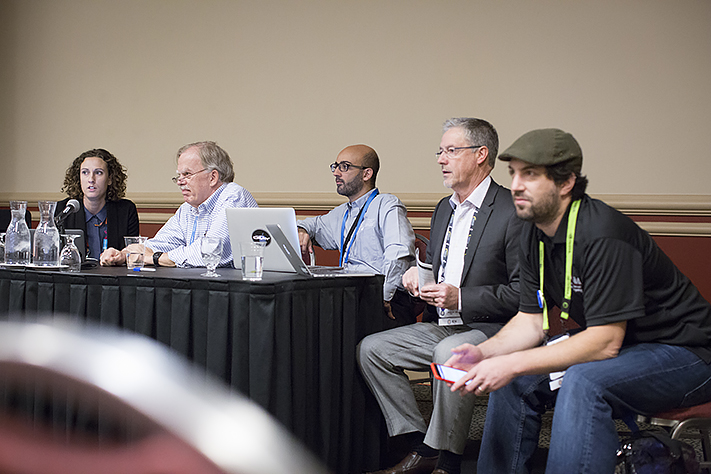By Nicholas Demille, KAUST News
A KAUST team of staff, faculty and students recently traveled to Salt Lake City, Utah, for the International Conference for High-Performance Computing, Networking, Storage and Analysis (SC16). The conference kicked off on November 13, and the exhibition began on November 14 at the Salt Palace Convention Center.
The University joined corporate exhibitors such as the Intel Corporation, NVIDIA, IBM, Cray and Microsoft; university exhibitors such as Indiana University, the University of Maryland, Purdue and Stanford; and U.S. governmental organizations such as the Department of Energy (DoE), the National Center for Atmospheric Research (NCAR), NASA and others. The KAUST booth in the main hall featured a team of experts from the University who discussed KAUST research, career opportunities, student internships and more with visitors.
Presenting KAUST research

KAUST Computational Scientist Bilel Hadri and a panel of U.S. Department of Energy co-panelists speaking about burst buffer technology during SC16. By Nicholas Demille.
A number of KAUST faculty, research scientists and students engaged in panel discussions or took to the lectern to talk about their work. On November 15, KAUST Computational Scientist Bilel Hadri from the University’s Supercomputing Core Lab joined fellow panelists Deborah Bard, David Paul and Wahid Bhimji from the Lawrence Berkley National Laboratory and Robert Ross from the Argonne National Laboratory for a session on burst buffer technology.
"We have a few applications at KAUST that spend a big portion of their computational power writing data, and that takes a long time. Essentially, the rate of reading and writing involving the disk or memory is much slower than the rate of computing, and this is with all supercomputers," said Hadri. "My research into the use of burst buffer technology allows us to overlap the writing with the computing, which speeds us to the final research outcome."

Amani Al-Onaizi
Also on November 15, the Director of the KAUST Extreme Computing Research Center, David Keyes was joined by Ph.D. candidate Amani Al-Onazi to present their latest findings with KAUST Computational Scientist George Markomanolis as part of a poster session in the main Exhibit Hall.
"I had the opportunity to talk with leaders in my field who gave me encouraging comments and useful suggestions," said Al-Onazi. "Presenting at the SC16 poster session increased my confidence and proficiency in explaining my research in front of highly distinguished scientists."
At the core of KAUST research
One of the biggest selling points at KAUST is the tremendous support in both facilities and technical expertise that the University's Core Labs provide. Two of the 10 Labs, the Visualization Core Lab and the KAUST Supercomputing Core Lab, are directly related to supercomputing research.
"The Core Labs as a research support entity provides services to researchers, faculty and industrial partners," said Daniel Acevedo-Feliz, director of the Visualization Core Lab. "We need to be at the cutting edge of all of the technologies that we provide, and attendance at SC16 helps us do just that."
Staying at the top
On November 16, the Top 500 organization again ranked the KAUST supercomputer Shaheen the no. 1 supercomputer in the Middle East. The Cray XC40 is now the 15th fastest computer in the world, according to Top 500.
David Keyes, director of the KAUST Extreme Computing Research Center, stands with the Top500 certificate for the fastest supercomputer in the Middle East. The award was given to the KAUST team during the SC16 proceedings in Salt Lake City, Utah.

"Shaheen puts KAUST in an inner circle of Cray customers that includes Los Alamos, Lawrence Berkeley, and Oak Ridge National Laboratories in the U.S., as well as the leading German, Swiss and British supercomputer centers," said Keyes. "Since these centers run many of the same packages in climate modeling, chemistry and materials science, KAUST investigators participate directly in discussions at the computational frontier of these and other domains of discovery."
"The global rank of Shaheen is impressive, but the main impact of Shaheen for KAUST is that it conveys our computational DNA, as no other university yet owns and operates for its own use a computer of such capability," Keyes continued. "Shaheen is also the dominant contributor to the international computational ranking of Saudi Arabia, making it one of the top 10 countries in the world for aggregate simulation capability."
Visiting KAUST
A number of high-profile visitors stopped by the KAUST booth, including Omar Ghattas of UT Austin, Deborah Bard from the Lawrence Berkley National Laboratory and Jack Dongarra from the Knoxville, Tennessee-based Innovative Computing Laboratory.
Thomas Schulthess of ETH Zurich also stopped by the booth. Schulthess will be one of the keynote speakers at the High-Performance Computing Saudi Arabia (HPC Saudi) event in March 2017. Poster submission and tutorial proposal deadlines are January 7, 2017. Early registration for KAUST accommodation is January 31. Visit www.hpcsaudi.org for complete information.

